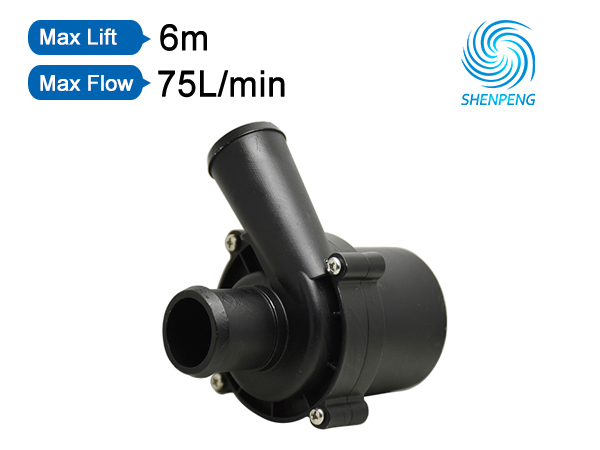Smart Toilet Water Pump: Core Technologies Explained (Brushless Motor & PWM Control)
Published:2025-08-15

As technology advances, smart toilets have steadily found their way into households worldwide, becoming a key bathroom appliance that elevates daily living standards. Among the various components of a smart toilet, the DC brushless water pump stands as a core element—its performance directly shapes the user experience. This article delves into the core technologies of DC brushless water pumps in smart toilets.
Analysis of Brushless Motor Structure
The key advantage of DC brushless water pumps stems from their motor’s adoption of electronic commutation technology (brushless DC motor technology). Equipped with Hall sensors to detect rotor position in real-time, a controller precisely regulates winding current commutation, entirely eliminating the brushes and commutators of traditional brushed motors. This technological breakthrough fundamentally resolves issues like wear, sparking, and noise caused by mechanical contact in brushed motors, extending the motor’s lifespan to over 3 times that of traditional models.
In high-end pump designs, some integrate magnetic drive sealing technology, using magnetic coupling of permanent magnets to transmit power, achieving complete isolation between the pump chamber and motor. Combined with a ceramic shaft core (with hardness exceeding HV1200) and corrosion resistance, this ensures stable operation in long-term humid environments. For example, Shenpeng Technology’s smart toilet-specific water pumps, which adopt this composite structure, maintain a flow decay rate of less than 5% in 5000-hour continuous operation tests—far outperforming the industry average.
Compared to traditional brushed motors, DC brushless water pumps deliver significant energy efficiency improvements, saving over 30% energy. Brushed motors, plagued by brush friction losses, typically have an efficiency below 60%, while brushless motors, optimized via electronic commutation, maintain efficiency stably between 85% and 90%.
Analysis of Pump Control Logic
The pump’s control logic is critical for precise flow regulation. Over 90% of smart toilets use PWM (Pulse Width Modulation) speed control technology. By adjusting the duty cycle of pulse signals, motor speed is linearly regulated, enabling stepless flow control. For instance, in the 臀部清洗 (hip washing) function, the system outputs a 15% duty cycle PWM signal, stabilizing flow at 1.5L/min; when switching to flushing mode, the duty cycle instantly jumps to 80%, reaching a flow rate of 18L/min with a response time of less than 0.3 seconds.
Compared to 0-5V analog signal speed control, PWM technology offers distinct advantages in smart toilets: stronger anti-interference capabilities, adapting to electromagnetic interference in humid environments; higher control precision, with flow errors within ±3%; and better compatibility with the toilet’s main control board digital interfaces, eliminating the need for additional analog-to-digital conversion modules.
Water Circuit Design Solutions and Application Cases
In smart toilet water system design, three main pump configurations are commonly used:
1. High-flow single-pump solution: Shenpeng Technology’s P6099 series and P5053 high-flow pumps are representative. The P6099 series handles higher pipe resistance, ensuring stable high-flow output even in complex water circuit environments; the P5053 high-flow pump, with its exceptional flow performance, meets the demands of smart toilets requiring strong flushing power and efficiency, delivering robust water flow.
2. Speed-adjustable single-pump + switching valve solution: Shenpeng’s P5039 series and P5051+PWM combination lead this category. PWM speed control enables precise flow adjustment, while the switching valve facilitates water circuit switching—balancing flexibility in flow regulation and convenience in circuit switching to meet diverse water flow needs for different functions.
3. Upper flush small pump + main flush medium pump solution: Shenpeng’s P4007 series (small pump) and P5051 series (medium pump) are ideal here. The P4007 small pump is designed for upper flush functions, providing stable, moderate low flow to ensure comfortable experiences for feminine washing and hip washing. The P5051 medium pump focuses on main flushing, with moderate flow and pressure to ensure effective waste removal.
For the "0 water pressure flushing" function, Shenpeng’s water pumps employ a "pre-stored water + instant pressurization" design. When inlet pressure drops below 0.05MPa, the pump automatically enters Boost mode, operating at 12000rpm to boost water pressure to over 0.3MPa. Combined with a siphon pipe design, it achieves full flushing in one go—even in old communities with no tap water pressure. A leading brand’s model equipped with this solution earned a Class 1 water efficiency rating in national certifications, using only 3.8L per flush.
In dual-water circuit designs, single-pump systems, via PWM speed control and solenoid valve coordination, switch water circuits in 0.5 seconds; dual-pump systems use the main control board for time-sharing control, enabling parallel operation of upper and lower flushing (e.g., nozzle self-cleaning during waste removal to boost efficiency). Shenpeng Technology provides customized motor parameters to ensure seamless integration with different brands’ control systems.
In summary, DC brushless water pumps—powered by electronic commutation, precise PWM control, and flexible water circuit configurations—drive functional upgrades in smart toilets. With over a decade of expertise, Shenpeng Technology continues to optimize motor efficiency and system compatibility, offering diverse solutions to smart toilet manufacturers and advancing the industry toward energy efficiency and intelligence.
- Distribution in Water Heater Mattresses: Why BLDC Pumps Ensure Uniform Heating
- How BLDC Pumps Ensure Precise Flow in Water Dispensers
- Why BLDC Pumps Are Essential for Smart Toilets
- The Critical Role of Automotive Electronic Water Pumps in New Energy Vehicle Battery Thermal Management
- Noise Control Technology for Smart Toilet Water Pumps: Enhancing Quiet Operation in Modern Bathrooms
- Unveiling the Working Principle of Automotive Electronic Water Valves
- Comparative Analysis of Liquid-Cooled Pumps vs. Air-Cooled Systems for EV Charging Stations
- Technical Application of Brushless DC Motors in Energy Storage Circulation Pumps
- Water Heater Pump: Efficiency Upgrade for Low-Voltage Systems
- How Dishwasher Water Pumps Enhance Cleaning Coverage Through Stable Operation?
